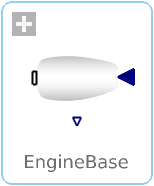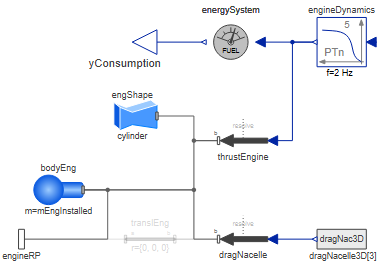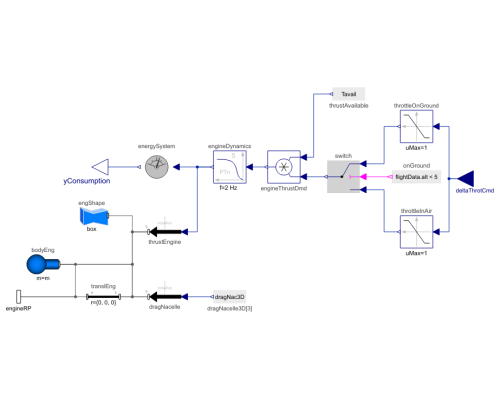WOLFRAM SYSTEM MODELER
EngineBaseInterface for engines |
|
Diagram
Wolfram Language

SystemModel["Aircraft.Physical.FixedWing.Parts.Propulsions.Engines.Interfaces.EngineBase"]

Information
This class is the engine base model, which all engine types extend, and contains the structure to model thrust and drag forces acting on the engines as well as the forces and torques due to the mass and inertia tensor of the engine (if the weight estimation method is used). Additionally, the fuel or energy consumption is calculated in the energySystem component, and the engShape component visualizes the engine if no complete CAD model of the aircraft is used.
The equations defining the thrust available, drag force, dimensions and mass properties of the engine are found in the respective engine type models, namely the TurbofanEngine, TurbojetEngine, TurbopropEngine, PistonEngine and ElectricEngine models.
Solving Net Thrust
The net thrust is essentially the product of the thrust available and the throttle position command (deltaThrotCmd), which usually ranges from 0 to 1. When the aircraft is on the ground, the possible thrust reverser is enabled, thus increasing the throttle position range below 0 as far as the value of the engine parameter negThrust is. Figure 1 shows how the switch between the throttle position ranges is made at the altitude of 5 m. However, takeoff, taxiing or landing currently cannot be modeled in the Aircraft library.
To simply model the engine dynamics, the product of the thrust available and throttle position is put through a CriticalDamping component to get the actual net thrust generated by the engine.
Figure 1: Model to calculate the net thrust.
Application of the Forces and Animation
Figure 2 shows how the net thrust is sent to the energySystem for fuel/energy consumption calculations and how the net thrust and drag forces are applied at the engine reference point frame (engineRP), which refers to the rear end of the engine. Similarly, the bodyEng and engShape components representing the mass properties of the engine and the engine visualization, respectively, are connected to the engine reference point frame.
Should the weight estimation method not be used, the bodyEng component will be disabled and both forces and engShape will be routed through the fixed zero translation (translEng) directly to the engine reference point frame.

Figure 2: Application of the forces at the engine reference point when weight estimation is used.
Parameters (5)
| weightEst |
Value: Type: Boolean Description: true, if weight estimation method is used for masses, center of mass location and inertia tensor |
|---|---|
| bWing |
Value: Type: Length (m) Description: Main wing span |
| SrefWing |
Value: Type: Area (m²) Description: Main wing reference area |
| CADshapes |
Value: Type: Boolean Description: true, if external CAD files are used for animation |
| negThrust |
Value: Type: Real Description: Maximum negative thrust (0 to 1 of thrust available) |
Inputs (1)
| flightData |
Type: FlightData Description: Global flight data variables |
|---|
Connectors (3)
| deltaThrotCmd |
Type: RealInput Description: Throttle position command |
|
|---|---|---|
| engineRP |
Type: Frame_b Description: Connector to engine reference point |
|
| yConsumption |
Type: RealOutput Description: Consumed electric energy or fuel in an engine |
Components (15)
| flightData |
Type: FlightData Description: Global flight data variables |
|
|---|---|---|
| energySystem |
Type: EnergySystem Description: Model to calculate the consumed electric energy or fuel in an engine |
|
| thrustEngine |
Type: WorldForce Description: Engine net thrust |
|
| engShape |
Type: FixedShape Description: Engine visualization |
|
| thrustAvailable |
Type: RealExpression Description: Thrust available of one engine |
|
| engineThrustDmd |
Type: Product Description: Thrust demand for one engine |
|
| engineDynamics |
Type: CriticalDamping Description: Simplified model of the engine dynamics |
|
| throttleOnGround |
Type: Limiter Description: Limits the throttle from maximum negative thrust to 1 once on the ground |
|
| dragNacelle3D |
Type: RealExpression[3] Description: Drag due to one nacelle |
|
| dragNacelle |
Type: WorldForce Description: Drag of nacelle |
|
| translEng |
Type: FixedTranslation Description: Translation from engine rear end to the point where thrust and drag are acting on (currently no translation) |
|
| bodyEng |
Type: Body Description: Mass and inertia of engine |
|
| switch |
Type: Switch Description: Switch between two Real signals |
|
| throttleInAir |
Type: Limiter Description: Limits the throttle from 0 to 1 once airborne |
|
| onGround |
Type: BooleanExpression Description: Boolean expression for indicating aircraft being on ground |
Extended by (6)
|
Aircraft.Physical.FixedWing.Parts.Propulsions.Interfaces.ConventionalPropulsion Type of engine model used in the propulsion system |
|
|
Aircraft.Physical.FixedWing.Parts.Propulsions.Engines.ElectricEngines Electric engine: unparameterized |
|
|
Aircraft.Physical.FixedWing.Parts.Propulsions.Engines.PistonEngines Piston engine: unparameterized |
|
|
Aircraft.Physical.FixedWing.Parts.Propulsions.Engines.TurbopropEngines Turboprop engine: unparameterized |
|
|
Aircraft.Physical.FixedWing.Parts.Propulsions.Engines.TurbojetEngines Turbojet engine: unparameterized |
|
|
Aircraft.Physical.FixedWing.Parts.Propulsions.Engines.TurbofanEngines Turbofan engine: unparameterized |

